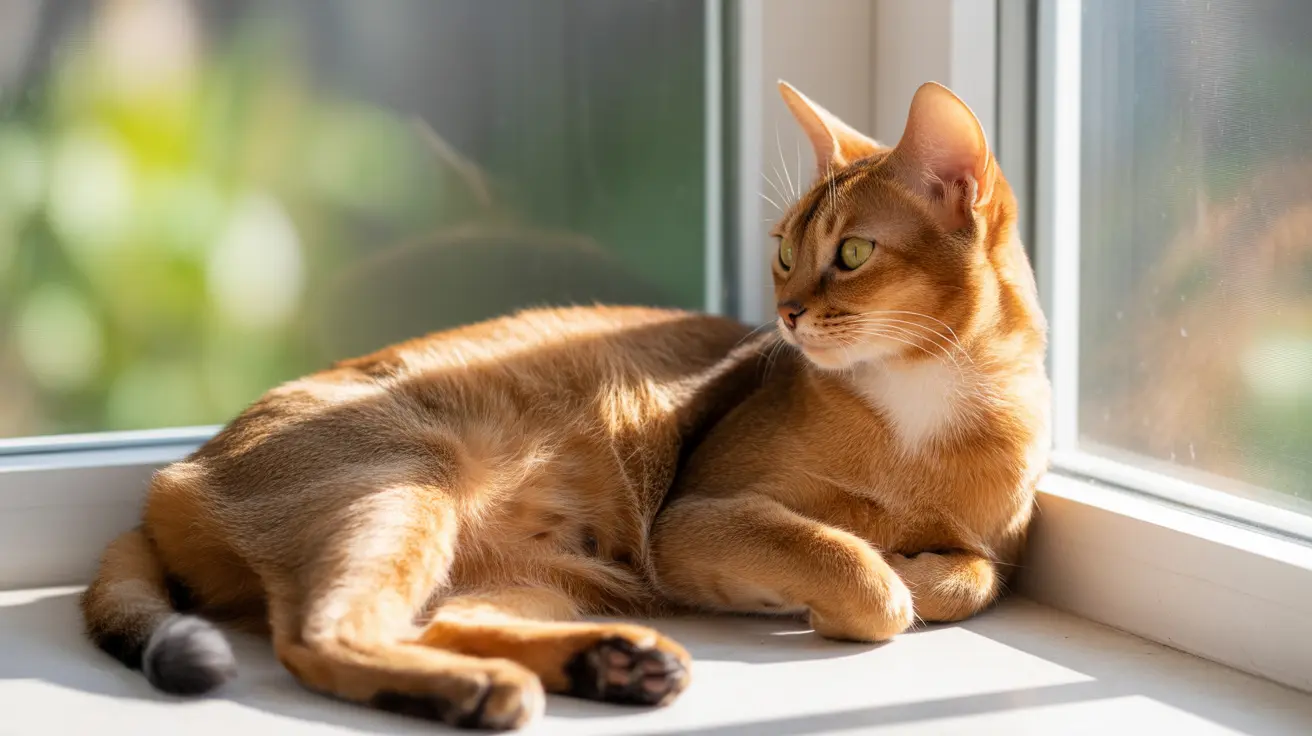The Four Classic Abyssinian Colors
Abyssinian cats are recognized in four primary colors by major cat registries worldwide:
Ruddy (Usual/Tawny)
The original and most common Abyssinian color features a warm, reddish-brown base coat with black or dark brown ticking. Each hair displays bands of color, creating the breed's signature shimmer effect. The result is a rich, warm coat that appears to glow from within.
Sorrel (Red/Cinnamon)
This striking variation showcases a copper or bright apricot base with chocolate-brown ticking. Sorrel Abyssinians possess a notably warmer and lighter appearance compared to their ruddy counterparts, making them particularly eye-catching in natural light.
Blue
Blue Abyssinians display a warm beige base coat complemented by blue-gray ticking. This creates a softer, more subdued appearance that many find particularly elegant. The overall effect is reminiscent of a misty morning, with subtle color variations throughout the coat.
Fawn
The most delicate of the standard colors, fawn Abyssinians feature a creamy peach base with rosy-beige ticking. This gentle color combination results in an exceptionally soft and refined appearance that's highly sought after by enthusiasts.
Silver Variations and Special Colors
Beyond the four classic colors, some registries recognize silver variations of each standard color. These cats possess a silvery-white base coat with corresponding ticking colors. However, it's important to note that not all cat associations accept silver variations, particularly in North America.
Silver Color Recognition
The recognition of silver Abyssinians varies by registry:
- TICA and GCCF (UK) recognize silver variations
- CFA does not currently recognize silver variants
- Silver cats maintain the same ticking patterns but with a lighter base coat
The Science Behind the Colors
The unique appearance of Abyssinian cats is the result of complex genetic interactions:
Ticked Pattern Genetics
The distinctive ticked pattern is controlled by the dominant Ta gene, which creates the alternating bands of color on each hair shaft. This genetic feature is what gives Abyssinians their characteristic glittering appearance.
Color Inheritance
Color inheritance in Abyssinians follows specific patterns:
- Ruddy is dominant over other colors
- Blue, fawn, and sorrel are recessive traits
- Both parents must carry specific color genes to produce certain colors
- Silver coloring requires the presence of the inhibitor gene
Frequently Asked Questions
What are the main recognized colors for Abyssinian cats and how do they differ?
The four main recognized colors are ruddy (reddish-brown with black ticking), sorrel (copper with chocolate ticking), blue (beige with blue-gray ticking), and fawn (cream with rosy-beige ticking). Each color has distinct characteristics and varying intensity of ticking.
How does the ticked coat pattern in Abyssinians affect their color appearance?
The ticked pattern creates alternating bands of color on each hair shaft, resulting in an iridescent, shimmering appearance. This pattern enhances the depth and richness of each color variation.
Can Abyssinian cats have silver or experimental colors, and are these accepted by cat registries?
Silver variations exist for all four main colors but are not universally accepted. While TICA and GCCF recognize silver variants, the CFA does not. Experimental colors exist but are not typically accepted in show circuits.
How do genetics influence the color variations and inheritance in Abyssinian cats?
Color inheritance is controlled by multiple genes, including the dominant ticked (Ta) gene and various color-modifying genes. Ruddy is dominant, while other colors are recessive, requiring specific genetic combinations from both parents.
What should breeders know about producing specific Abyssinian cat colors like sorrel or blue?
Breeders must understand that recessive colors like sorrel and blue require both parents to carry the specific color genes. Careful genetic testing and knowledge of color inheritance patterns are essential for successful color-specific breeding programs.






